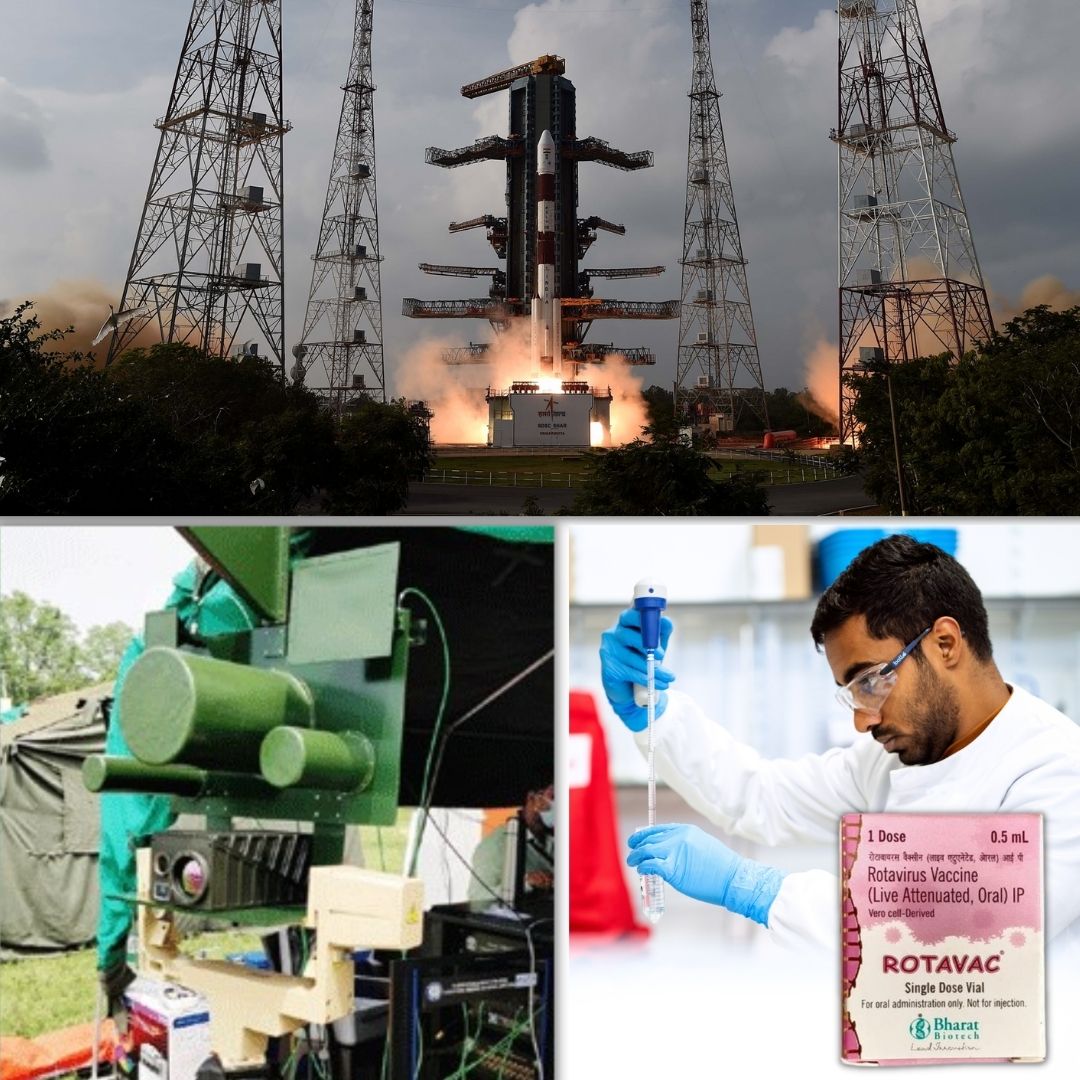Rewind 2021: Here's Top 5 Scientific, Tech Developments That Made Indians Proud
Writer: Anuksha Bharat
She is currently pursuing Masters in Media and Communication Studies from Christ (Deemed to be University). She likes exploring different things, people, places around her and is keen to know about them. She wishes to be a changemaker for society as growing up. She is now able to see various issues that are present around her. Also, being a part of this world she wants to contribute and make this world a better place to live.
India, 31 Dec 2021 9:49 AM GMT | Updated 31 Dec 2021 11:12 AM GMT
Editor : Snehadri Sarkar |
While he is a massive sports fanatic, his interest also lies in mainstream news and nitpicking trending and less talked about everyday issues.
Creatives : Snehadri Sarkar
While he is a massive sports fanatic, his interest also lies in mainstream news and nitpicking trending and less talked about everyday issues.
Despite facing multiple setbacks in 2021 due to the ongoing COVID pandemic, India still made significant strides in science and tech.
India, while battling against the ongoing COVID pandemic, still managed to rise in 2021 with its remarkable scientific developments. This is proof of the potential and determination for its ambitions. Irrespective of multiple setbacks in health, economy, politics, it performed well in Science. Here are some of the major developments that it brought!
DRDO Anti-Drone Technology
The Defence Research and Development Organisation developed an anti-drone technology that can detect and counter UAV's and has a radar system that covers 360 degrees. This system was made for VIP(Very Important Person) protection duties in 2020 and 2021. It would help the armed forces detect, intercept, and destroy the enemy's drones. These systems have a laser-based kill technology and are fit for soft-kill(for jamming the communication links of drone) and hard kill(laser-based hard kill to destroy the drone) of enemy drones.
This drone can identify and jam micro drones to 3km and fire laser signals to the target-present at a distance of 1-2.5km. The drones did two blasts in Jammu Air Force Station for a trial. One of them caused damage to the roof of a building, and the other one was done in an open area, as per Indian Air Force (IAF). After these blasts, there was no damage found to any equipment though two personnel got minor injuries.
This system can be used to target unmanned drones, explosives and ammunition across the western borders from the terror groups end, especially in Jammu and Kashmir and Punjab, as there are security concerns in these states.
The Anti-Drone System has Electro-optical (EO) and Infrared (IR) sensors that can identify micro drones till 2Km of distance. If connected with machine vision and artificial intelligence (AI) algorithms, these sensors reduce the risk of unclear decisions.
DRDO Anti-Drone Technology has been transferred to Bharat Electronics Limited (BEL). Transfer of Technology (ToT) of the Anti-Drone System is also offered to other companies.
Drone policy in India- According to Times Now News report, officials believe that Pakistan-based terrorists are planning to attack the Air Force Station. The Jammu and Kashmir Police arrested an alleged Lashkar-e-Taiba operative with an improvised explosive device (IED) that weighed around 5Kg in Jammu. An attack was made on the Air Force Station after a few hours of the arrest.
Prime Minister held a meeting to discuss implementing the drone policy for India in which Cabinet Ministers, Defence Minister Rajnath Singh, Home Minister Amit Shah and Civil Minister Hardeep Singh Puri were present.
Bharat Biotech's Rotavac 5D Got Approved By WHO
Bharat Biotech prepared a vaccine in collaboration with the Department of Biotechnology, Government of India and 16 other international partners for Rotavirus, named Rotavac 5D and the World Health Organisation(WHO) approved for it. Bharat Biotech is a Hyderabad-based company, and its vaccine formulation can be taken without any buffer. It has a low dose volume of 0.5ml that makes it easy to calculate, cold-chain management, and low biomedical waste disposal after vaccination. It is used to prevent the Rotavirus infection, commonly found in infants and young children.
The prequalification helps in Rotavac 5D by UN agencies, UNICEF and Pan American Health Organisation (PAHO). It's a validation of the global quality and safety standards required for pediatric vaccines. As per Suchitra Ella, Joint Managing Director of Bharat Biotech said, "Rotavac and Rotavac 5D are projects conceived, innovated and executed in India in collaboration with Indian and global partners. It took 30 years to develop a novel Rotavirus vaccine, and it's the major advancement that can be made in Rotavirus disease." This vaccine can be stored at 2-8°C and should be administered five drops orally. It is available in single-dose, multi-dose vials and pre-filled syringes. Bharat Biotech has kept Rs. 1430 for pre-filled syringes Rotavac 5D and Rs. 689 for Rotavac vaccine.
As per the Hindu Business Line report, Rotavirus has been causing more than 200,000 deaths and 2 million hospitalisations worldwide. It is the main cause of Diarrhoea in children less than five years of age globally.
CSIR-CMERI Developed Oxygen Enrichment Technology To Treat Covid Patients
The CSIR-CMERI has developed oxygen enrichment technology for treating Covid-19 patients that require an oil-free reciprocating compressor, Oxygen grade zeolite sieves and pneumatic components. The Oxygen enrichment unit can be placed in the hospital's isolation ward and can be helpful for the ones who need oxygen.
Council of Scientific and Industrial Research (CSIR)- Central Mechanical Engineering Research Institute(CMERI) in collaboration with the Ministry of Small and Medium Enterprises-Development Institute (MSME-DI) conducted a seminar on Oxygen Enrichment Technology on 25th April 2021 where Dr Anupam Sinha, Sr. Principal Scientist, CSIR-CMERI, Durgapur stated that the Oxygen enrichment unit had been transferred to two industries. This unit has the potential to give mechanical air to the range of 15LPM with oxygen purity of more than 90%. In the case of requirement, this unit can also give up to 70LPMat purity of 30%.
This unit can also be used in adjunct treatment for sleep apnea (in conjunction with a continuous positive airway pressure unit).
Working of Oxygen enrichment technology- As per the CMERI, the device collects oxygen from the surrounding by selectively removing nitrogen to supply to oxygen-enriched air. This concentrated oxygen is then delivered to the patient who has breathing problems through a mask or nasal cannula for improving oxygenation in the blood. It works through Pressure Swing Adsorption (PSA) and utilises Zeolite Columns for selective removing of nitrogen from air under particular pressure; hence this increases the oxygen concentration.
Natco Pharma Launched Brivaracetam To Cure Epilepsy In India
Natco Pharma has launched a drug named Brivaracetam under the brand BRECITA to treat Epilepsy in the country. The Brivaracetam tablets are available in two strengths, 50mg and 100mg in 25/- and 35/- per tablet, respectively. According to Guidelines for Epilepsy Management in India, there is an estimation of 5-10 million Epilepsy patients in the country. The Hindu report developed the drug by UCB Pharma and marketed by Dr. Reddy under the brand name Briviact.
Epilepsy in India- Epilepsy is a brain disorder that causes seizures due to neurobiological, cognitive, psychological, and social consequences. It can be commonly seen in rural areas as compared to urban areas. In rural areas, there is already a lack of awareness, poverty, ignorance, and then this disease comes with social stigma and isolation, which becomes an add-on to its widespread. There are less than 2000 neurologists with millions of epileptic patients in India. It's high time that there is a need to create awareness and work to treat this disease.
ISRO Launched Polar Satellite Launch Vehicle (PSLV)-C51
ISRO launched PSLV-C51 and Amazonia-1, and other 18co-passenger satellites on 28th February 2021 from Satish Dhawan Space Centre (SDSC), Sriharikota. It lifted off from the first launch pad of SDSC SHAR at 10:24 hours (IST). After flying for 17 minutes, it injected the Amazonia-1 into its planned orbit. After 1 hour 38 minutes, all the 18 co-passenger satellites were separated successfully from the PSLV in a pre-decided sequence.
It is the first satellite designed, integrated, and operated by Brazil. ISRO Chairman Dr K Sivan congratulated the team of ISRO and Brazil for the achievement. H. E Marcos Cesar pontes, Minister of Science, Technology, and Innovation, Brazil, also congratulated the team of ISRO for the successful launch. He also stated that this partnership between India and Brazil would further strengthen ties between the two countries.
Amazonia-1 - As per the ISRO, Amazonia-1 is the optical earth observation satellite on National Institute for Space Research (NIPE). It will give users remote sensing data to monitor deforestation in the Amazon region and analyse diversified agriculture across the Brazilian territory.
PSLV-C51/Amazonia is the first commercial mission of NewSpace India Limited (NSIL), a Government company under the Department of Space.
The 18 co-passenger satellite on PSLV-C51 has four from IN-SPAce and fourteen from NSIL. The fourteen satellites from NSIL were the commercial satellites from India (1) and the USA (13). From the 4 satellites from IN-SPAce, three were UNITYsats that were designed and built as a joint development by Jeppiaar Institute of Technology, Sriperumbudur, G.H Raisoni College of Engineering, Nagpur, and Sri Shakti Institute of Engineering and Technology, Coimbatore and one was Satish Dhawan Sat (SDSAT) from Space Kidz India.
PSLV-C51 is the 53rd flight of PSLV and the 3rd flight of PSLV in the 'DL' configuration (with two strap-on motors). This was the 78th launch vehicle mission from SDSC SHAR, Sriharikota.
Also Read: Looking Back At 2021- Top Indian Startups That Dominated Headlines
 All section
All section














